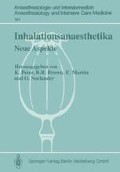Zusammenfassung
Mit der Einführung von Halothan in die klinische Praxis im Jahre 1958 begann eine neue Ära der Anästhesie. Dieses potente, nicht brennbare Pharmakon machte eine rasche und leicht steuerbare Anästhesietiefe möglich und erlaubte dem Chirurgen die gefahrlose Anwendung von Elektrokoagulation. Der wahrscheinlich größte Vorteil dabei war der Sprung in ein Zeitalter differenzierter elektronischer Überwachungsmethoden, die durch dieses nicht entzündbare Anästhetikum möglich wurden. Dank Überwachungstechniken, die die Entwicklung der Raumfahrt mit sich gebracht hat, verbunden mit einem ständig zunehmenden Wissen auf den Gebieten der Physiologie und Pathophysiologie, werden nun chirurgische Verfahren, die bisher als zu gefährlich und komplex galten, routinemäßig durchgeführt.
Access this chapter
Tax calculation will be finalised at checkout
Purchases are for personal use only
Preview
Unable to display preview. Download preview PDF.
Literatur
Bottinger LE, Dalen E, Hallen B (1976) Halothane — Induced liver damage: An analysis of the material reported to the Swedish Adverse Drug Reaction Commitee. 1966–1973. Acta Anesthesiol Scand 20:40
Brown BR Jr, Sipes IG, Sagalyn AM (1974) Mechanisms of acute hepatic toxicity: chloroform halothane, and glutathione. Anesthesiology 41:554
Bunker JP, Forrest WH, Mostellar T, Vandam LD (1969) A study of the possible association between halothane anesthesia and postoperative hepatic necrosis (National Halothane Study). US Government Printing Office, Washington
Dykes MH (1984) Is enflurane hapatotoxic (editorial). Anesthesiology 61:235
Inman WHW, Mushin WW (1974) Jaundice after repeated exposure to halothane: An analysis of reports to the Committee on Safety of Medicine. Br Med J 1:5
Kline MM (1980) Enflurane hepatitis. Gastroenterology 79:126
Lindenbaum J, Liefer E (1963) Hepatic necrosis associated with halothane anesthesia. N Engl J Med 268:525
Lunam CA (1980) Halothane hepatotoxicity in a Guinea pig model. PhD dissertation, Flinders University of South Australia
Mazze RI, Shue GL, Jackson SH (1971) Renal dysfunction associated with methodyflurane anesthesia: A randomized, prospective clinical evaluation. JAMA 216:278
Mazze RI, Woodruff RT, Heerdt ME et al (1982) Isoniazid — Induced enflurane deflouridation in humans. Anesthesiology 57:5
McLain GE, Sipes IG, Brown BR Jr (1979) An animal model of halothane hepatotoxicity: Role of enzyme induction and hypoxia. Anesthesiology 51:321
Moult PJA, Sherlock S (1975) Halothane related hepatitis. A clinical study of 26 cases. Q J Med 44:99
Musher WW, Rosen M, Bowen DJ, Campbell H (1969) Halothane and liver dysfunction: A retrospective study. US Government Printing Office, Washington
Recknagel RO, Ghosal AK (1966) Lipoperoxidation as a vector in carbon tetrachloride hepatotoxicity. Lab Invest 15:133
Shingu K, Eger EI Jr, Johnson BH (1984) Hypoxia may be more important than reductive metabolism in halo thane-induced hepatic injury. Anesth Analg 61:824
Stier A, Alter H, Hessler V et al (1964) Urinary excretion of bromide in halothane anesthesia. Anesth Analg 43:723
Uehleke H, Hellmer KH, Tabarelli-Poplawski S (1973) Metabolic activation of halothane and its covalent binding to liver endoplasmic proteins in vitro. Nauyn Schmiedebrigs Arch Pharmacol 279: 39
Van Dyke RA, Chenoweth MB, van Posnak A (1964) Metabolism of volatile anesthetics. Biochem Pharmacol 13:1239
Vergami D, Tsantoulas D, Eddieston ALWF et al (1978) Sensitization to halothane-altered liver components in severe hepatic necrosis after halothane anesthesia. Lancet 11:801
Vergami D, Mieli-Gergami G, Alberti A et al (1980) Antibodies to the surface of halothane-altered rabbit hepatocytes in patients with severe halo thane-associated hepatitis. N Engl J Med 303:66
Virtue RW, Payne KW (1958) Postoperative death after fluothane. Anesthesiology 19:562
Vourc’h G, Schnoebelen E, Buck F, Fruhling L (1960) Hepatonephrite aigue mortelle apres anesthesie comportant de L.halothane (fluothane). Anesth Analg (Paris) 17:466
Widger LA, Gandolfi AJ, van Dyke RA (1976) Hypoxia and halothane metabolism in vivo: Release of inorganic fluoride and halothane metabolite binding to cellular caustituents. Anesthesiology 44: 197
Editor information
Editors and Affiliations
Rights and permissions
Copyright information
© 1986 Springer-Verlag Berlin Heidelberg
About this paper
Cite this paper
Brown, B.R. (1986). Gegenwärtiger Stand der Organtoxizität von Inhalationsanästhetika. In: Peter, K., Brown, B.R., Martin, E., Norlander, O. (eds) Inhalationsanaesthetika. Anaesthesiologie und Intensivmedizin / Anaesthesiology and Intensive Care Medicine, vol 184. Springer, Berlin, Heidelberg. https://doi.org/10.1007/978-3-662-07905-8_7
Download citation
DOI: https://doi.org/10.1007/978-3-662-07905-8_7
Publisher Name: Springer, Berlin, Heidelberg
Print ISBN: 978-3-540-15968-1
Online ISBN: 978-3-662-07905-8
eBook Packages: Springer Book Archive

